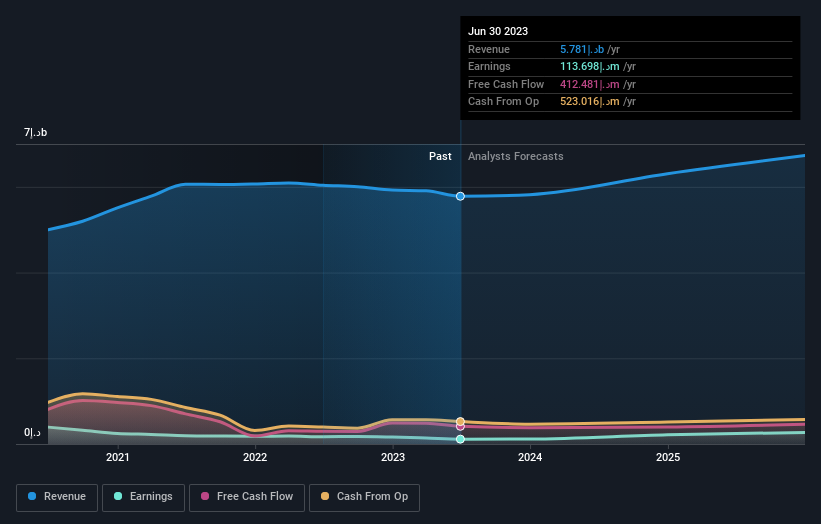Stock Analysis
- United Arab Emirates
- /
- Logistics
- /
- DFM:ARMX
Aramex PJSC's (DFM:ARMX) market cap dropped د.إ278m last week; Private companies bore the brunt

Key Insights
- Significant control over Aramex PJSC by private companies implies that the general public has more power to influence management and governance-related decisions
- A total of 2 investors have a majority stake in the company with 50% ownership
- Analyst forecasts along with ownership data serve to give a strong idea about prospects for a business
If you want to know who really controls Aramex PJSC (DFM:ARMX), then you'll have to look at the makeup of its share registry. We can see that private companies own the lion's share in the company with 50% ownership. Put another way, the group faces the maximum upside potential (or downside risk).
And following last week's 7.5% decline in share price, private companies suffered the most losses.
In the chart below, we zoom in on the different ownership groups of Aramex PJSC.
View our latest analysis for Aramex PJSC

What Does The Institutional Ownership Tell Us About Aramex PJSC?
Many institutions measure their performance against an index that approximates the local market. So they usually pay more attention to companies that are included in major indices.
Aramex PJSC already has institutions on the share registry. Indeed, they own a respectable stake in the company. This suggests some credibility amongst professional investors. But we can't rely on that fact alone since institutions make bad investments sometimes, just like everyone does. It is not uncommon to see a big share price drop if two large institutional investors try to sell out of a stock at the same time. So it is worth checking the past earnings trajectory of Aramex PJSC, (below). Of course, keep in mind that there are other factors to consider, too.

Aramex PJSC is not owned by hedge funds. Looking at our data, we can see that the largest shareholder is Caisse des Dépôts et Consignations with 28% of shares outstanding. In comparison, the second and third largest shareholders hold about 22% and 4.2% of the stock.
To make our study more interesting, we found that the top 2 shareholders have a majority ownership in the company, meaning that they are powerful enough to influence the decisions of the company.
While studying institutional ownership for a company can add value to your research, it is also a good practice to research analyst recommendations to get a deeper understand of a stock's expected performance. There are a reasonable number of analysts covering the stock, so it might be useful to find out their aggregate view on the future.
Insider Ownership Of Aramex PJSC
The definition of company insiders can be subjective and does vary between jurisdictions. Our data reflects individual insiders, capturing board members at the very least. Company management run the business, but the CEO will answer to the board, even if he or she is a member of it.
Most consider insider ownership a positive because it can indicate the board is well aligned with other shareholders. However, on some occasions too much power is concentrated within this group.
Our data cannot confirm that board members are holding shares personally. It is unusual not to have at least some personal holdings by board members, so our data might be flawed. A good next step would be to check how much the CEO is paid.
General Public Ownership
With a 40% ownership, the general public, mostly comprising of individual investors, have some degree of sway over Aramex PJSC. This size of ownership, while considerable, may not be enough to change company policy if the decision is not in sync with other large shareholders.
Private Company Ownership
Our data indicates that Private Companies hold 50%, of the company's shares. It might be worth looking deeper into this. If related parties, such as insiders, have an interest in one of these private companies, that should be disclosed in the annual report. Private companies may also have a strategic interest in the company.
Next Steps:
I find it very interesting to look at who exactly owns a company. But to truly gain insight, we need to consider other information, too. Consider for instance, the ever-present spectre of investment risk. We've identified 1 warning sign with Aramex PJSC , and understanding them should be part of your investment process.
If you would prefer discover what analysts are predicting in terms of future growth, do not miss this free report on analyst forecasts.
NB: Figures in this article are calculated using data from the last twelve months, which refer to the 12-month period ending on the last date of the month the financial statement is dated. This may not be consistent with full year annual report figures.
Valuation is complex, but we're helping make it simple.
Find out whether Aramex PJSC is potentially over or undervalued by checking out our comprehensive analysis, which includes fair value estimates, risks and warnings, dividends, insider transactions and financial health.
View the Free AnalysisHave feedback on this article? Concerned about the content? Get in touch with us directly. Alternatively, email editorial-team (at) simplywallst.com.
This article by Simply Wall St is general in nature. We provide commentary based on historical data and analyst forecasts only using an unbiased methodology and our articles are not intended to be financial advice. It does not constitute a recommendation to buy or sell any stock, and does not take account of your objectives, or your financial situation. We aim to bring you long-term focused analysis driven by fundamental data. Note that our analysis may not factor in the latest price-sensitive company announcements or qualitative material. Simply Wall St has no position in any stocks mentioned.
About DFM:ARMX
Aramex PJSC
Engages in the investment of freight, express, logistics, and supply chain management businesses in the United Arab Emirates, the Middle East, North Africa, Turkey, East and South Africa, Europe, North America, North and South Asia, and Oceania.
Proven track record with mediocre balance sheet.

